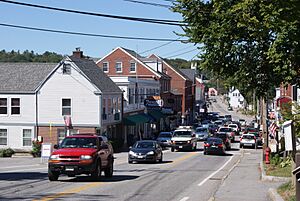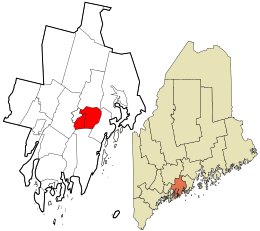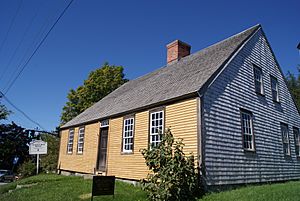Damariscotta, Maine facts for kids
Quick facts for kids
Damariscotta, Maine
|
|
|---|---|

Main Street, 2013
|
|

Location in Lincoln County and the state of Maine.
|
|
| Country | United States |
| State | Maine |
| County | Lincoln |
| Incorporated | 1848 |
| Area | |
| • Total | 14.71 sq mi (38.10 km2) |
| • Land | 12.42 sq mi (32.17 km2) |
| • Water | 2.29 sq mi (5.93 km2) |
| Elevation | 50 ft (20 m) |
| Population
(2020)
|
|
| • Total | 2,297 |
| • Density | 185/sq mi (71.4/km2) |
| Time zone | UTC-5 (Eastern (EST)) |
| • Summer (DST) | UTC-4 (EDT) |
| ZIP code |
04543
|
| Area code(s) | 207 |
| FIPS code | 23-16235 |
| GNIS feature ID | 0582432 |
Damariscotta is a lovely town in Lincoln County, Maine, United States. In 2020, about 2,297 people lived there. It is known as the "oyster capital of New England" because of its many oysters. Damariscotta and its nearby town, Newcastle, are often called the "Twin Villages." They are connected by a bridge over the Damariscotta River. The name Damariscotta comes from a Native American word meaning "place of many small fish." These small fish are called alewives.
Contents
History of Damariscotta
Early Inhabitants and Settlements
Long ago, the Wawenock (or Walinakiak) Abenaki Indians lived in this area. They left behind huge piles of oyster shells along the Damariscotta River. These shell piles, called middens, are about 2,500 years old. One famous shell midden, the Whaleback Shell Midden, is now a state historic site.
In 1631, some land here became part of the Pemaquid Patent. This was a special grant from the Plymouth Council to merchants from England. These merchants built a fort and a trading post in Pemaquid, which is now Bristol. Around 1640, some colonists moved upriver to settle what is now Damariscotta.
Challenges and Growth
Life was hard for early settlers. Their villages were attacked in 1676 during King Philip's War. Many people were forced to leave or were killed. Even after attempts to rebuild, there were more attacks during the French and Indian Wars. A fort called Fort William Henry was built in 1692 but was destroyed a few years later. The last battle of King William's War happened here in 1696.
Finally, peace came, and Damariscotta began to grow. It became an important center for trade. On March 15, 1848, Damariscotta officially became its own town. It was formed from parts of Bristol and Nobleboro.
Meaning of the Name and Local Industries
The name Damariscotta comes from an old Algonquian word, "Madamescontee." It means "place of an abundance of alewives." Alewives are small, salty fish that lay their eggs in Damariscotta Lake. The main part of the town is located near the lower falls on the Damariscotta River.
In the early days, Damariscotta had many industries. There were two sawmills, a factory that made matches, and a place for tanning leather. Many brickyards along the river made bricks. These bricks were used to build parts of Boston, like the Back Bay neighborhood.
Shipbuilding was especially important in the 1800s. Many beautiful clipper ships were built and launched from the town's shipyards. This brought a lot of wealth to Damariscotta. Because of this, many grand buildings were built in styles like Federal, Greek Revival, and Italianate. These old buildings give the town a special charm that attracts many tourists each summer.
Damariscotta is also home to the Skidompha Public Library. Its unique name is made from the first letters of several founders' last names.
The Damariscotta River
The end of the Damariscotta River is called the Great Salt Bay. This area is a special place where horseshoe crabs gather to mate. It was the first marine protected area in Maine. The river is also very important for oyster farming. About 80% of the farmed oysters in Maine come from this river.
Geography
Damariscotta covers a total area of about 14.71 square miles (38.10 square kilometers). Of this, about 12.42 square miles (32.17 square kilometers) is land, and 2.29 square miles (5.93 square kilometers) is water. The town is located on the Damariscotta River, which is a tidal estuary. This means it's a part of the river where the ocean's tides affect the water level. The highest point in town is Hunt Hill, which is about 350 feet (108 meters) above sea level.
Population Information
| Historical population | |||
|---|---|---|---|
| Census | Pop. | %± | |
| 1850 | 1,328 | — | |
| 1860 | 1,366 | 2.9% | |
| 1870 | 1,232 | −9.8% | |
| 1880 | 1,142 | −7.3% | |
| 1890 | 1,012 | −11.4% | |
| 1900 | 876 | −13.4% | |
| 1910 | 771 | −12.0% | |
| 1920 | 849 | 10.1% | |
| 1930 | 825 | −2.8% | |
| 1940 | 844 | 2.3% | |
| 1950 | 1,113 | 31.9% | |
| 1960 | 1,093 | −1.8% | |
| 1970 | 1,264 | 15.6% | |
| 1980 | 1,493 | 18.1% | |
| 1990 | 1,811 | 21.3% | |
| 2000 | 2,041 | 12.7% | |
| 2010 | 2,218 | 8.7% | |
| 2020 | 2,297 | 3.6% | |
| U.S. Decennial Census | |||
How Many People Live Here?
In 2010, there were 2,218 people living in Damariscotta. There were 1,051 households, which are groups of people living together. About 578 of these were families. The town had about 178.6 people per square mile (71.4 people per square kilometer).
Most of the people living in Damariscotta were White (97.0%). A small number were African American (0.4%), Asian (0.8%), or from other backgrounds. About 0.6% of the population was Hispanic or Latino.
Age and Gender
The average age of people in Damariscotta in 2010 was 50.7 years old.
- About 18.2% of residents were under 18 years old.
- About 6.5% were between 18 and 24 years old.
- About 17.7% were between 25 and 44 years old.
- About 27.8% were between 45 and 64 years old.
- About 29.8% were 65 years old or older.
When it came to gender, 44.2% of the population was male, and 55.8% was female.
Education
Damariscotta is part of the Maine AOS #93 school system. Steven Bailey is the Superintendent of Schools for this system.
Notable people
- Kate Aldrich, mezzo-soprano singer
- Anna Belknap, actress
- Bud Blake, cartoonist
- Charles A. Boutelle, naval officer and US congressman
- Glenn Chadbourne, illustrator
- Gene G. Chandler, speaker of the New Hampshire House of Representatives
- Barbara Cooney, children's author and illustrator
- Jessica Delfino, singer, songwriter, and comedian
- Ezra B. French, US congressman
- Ryan Gaul, actor
- Robert Gerringer, actor
- Hilton Kramer, art critic
- Bob Page, musician
- Frank Springer, cartoonist and comic book illustrator
- Betty Twarog, biochemist
Images for kids

See also
 In Spanish: Damariscotta (Maine) para niños
In Spanish: Damariscotta (Maine) para niños




